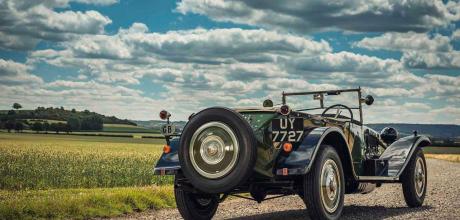1929 Lancia Lambda Tipo 223
It was one of the most technologically advanced cars of its era, and this one has an extraordinary back-story to tell: John Simister fulfils a long-held ambition and drives a Lancia Lambda. Words John Simister. Photography David Shepherd.
LANCIA LAMBDA 1920s innovator with a century of history
Switzerland was neutral during World War Two. Neutral, but not unaffected. René Niederer, a lawyer in Zurich, was engaged to Matty Kaars Sijpesteyn, but there was a problem. Matty was Dutch, and she lived back home in Holland – which, in 1940, was about to be invaded by Nazi forces. René was the second owner of a 1929 Lancia Lambda, which he had bought in 1937. He resolved to get into his car, drive it to Holland, and whisk Matty back to Switzerland and safety. As a Swiss national driving a Swiss-registered car he was, in theory, safe from capture by the Nazis as he drove through Germany, but he was still stopped several times – especially on the return journey with Matty and a carful of her belongings.
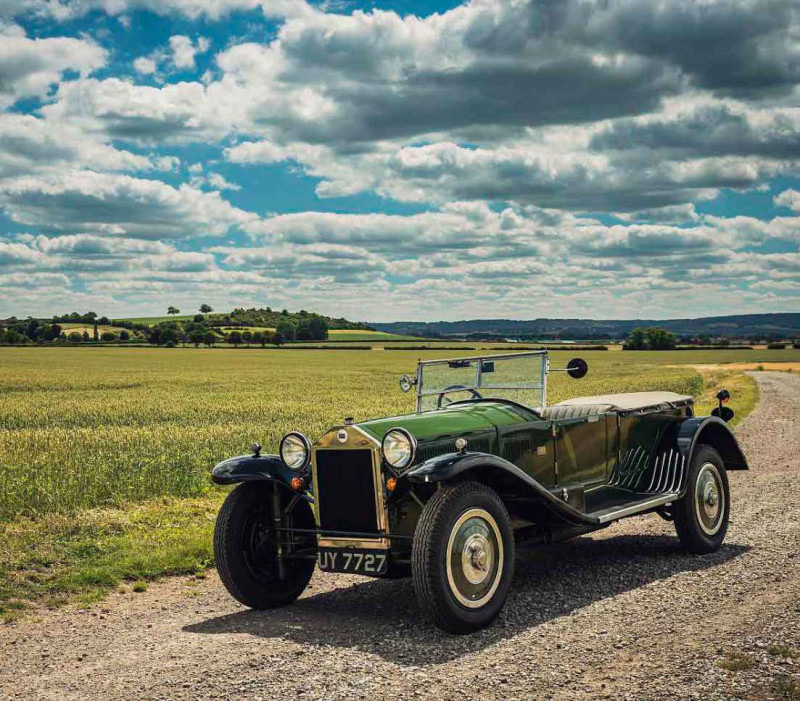
With days to spare before Holland was overrun, they returned safely to Zurich. The Lambda had behaved perfectly, and the married Niederers kept their faithful machine until 1953, by which time their house needed painting. Matty did a deal with the decorator that resulted in payment by Lambda. After the work was completed, Matty complained that a door needed more paint. The decorator agreed, but mentioned that the Lambda’s horn had just that morning stopped working…
The Niederer family heard no more news of the Lancia until 2009, but plenty happened in the interim. Three young lads had a great time with it in the 1950s, it got lightly restored in 1970 and gained a rare Romagnoni e Pirotta cylinder head (a pre-war go-faster-modification), and in 2006 it left Swiss ownership. One more owner later it arrived in Hertfordshire, a mile from my house, to take up residence in Mike Guest’s garage alongside an Aurelia B20.
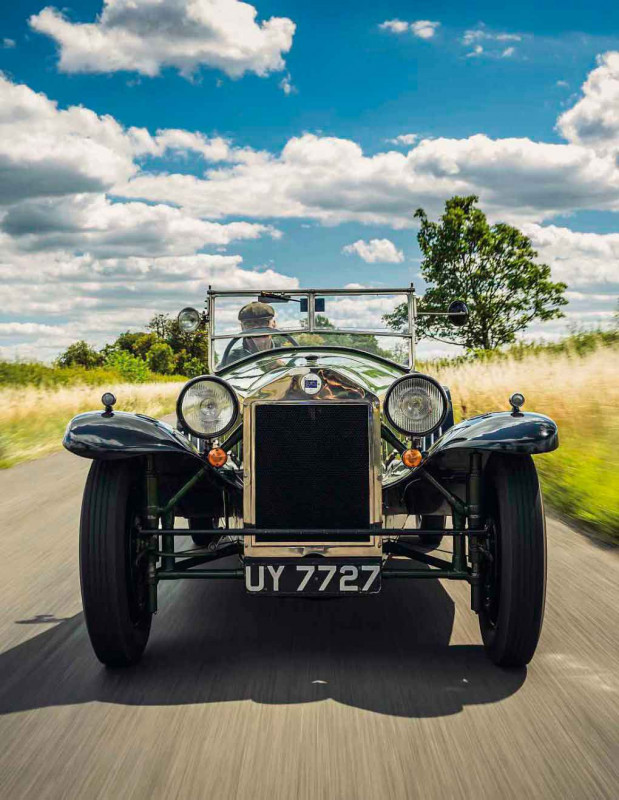
Guest got digging to learn more of his new purchase’s history. In 2009 he discovered a law firm in Zurich called Niederer, Kraft and Frey, and made contact on the off-chance of a Niederer connection. It paid off: Claus Niederer, one of the partners, was René and Matty’s son, and thus were the Lambda’s wartime exploits revealed.
Now, 80 years later, I’m looking over the Lancia in Mike Guest’s driveway. It’s a Tipo 223 with a ‘torpedo’ body, long-looking in the wheelbase despite being a short-chassis-model, and remarkably low in build for a car of its era. The reason for that low build is the reason I have been wanting to drive a Lambda for years: it has no chassis as such. It’s the world’s first quantity-produced unitary-construction car, and it has the added innovation for the time of independent front suspension (by sliding pillars). Together, these design features promise a sensation of structural stiffness and modern-feeling dynamic precision entirely unusual in 1929, and I’m itching to find out if the promise is kept.
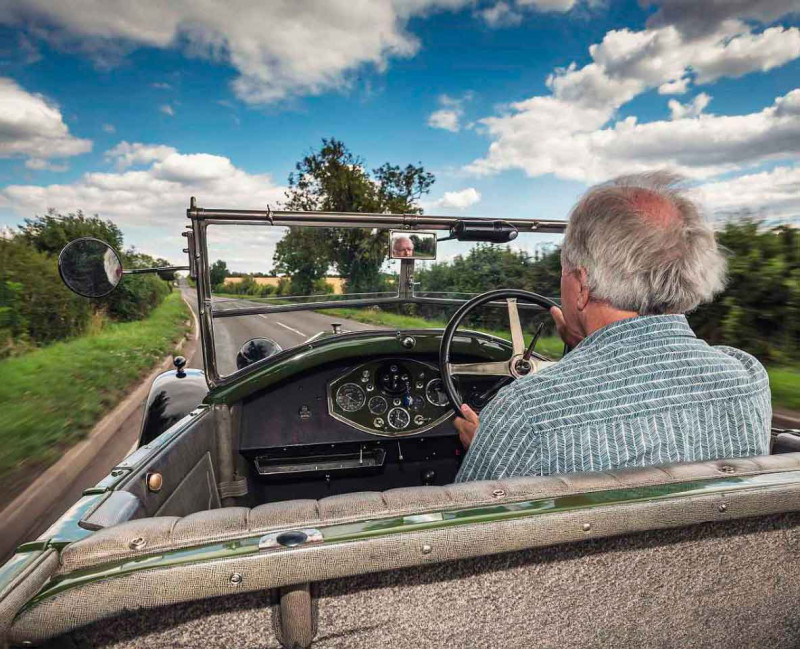
There’s a third thread of unconventionality, which sits in the nose: a V4 engine. Why, when space is hardly a problem under the Lambda’s bonnet? Simply because Vincenzo Lancia’s love of doing things differently led him to favour vee-engines, be they of four, six, eight or even 12 cylinders. But these were no normal vee-engines; they had vee-angles rather narrower than the norm, particularly so in the case of the first Lambda V4 – launched in 1922 – whose pairs of cylinders, with a capacity totalling 2120cc, were set just 13º apart.
By the time of Mike Guest’s eighth-series car, the engine had grown to 2570cc and the vee-angle had widened fractionally to 13º 40’, although an interim 2370cc engine had broadened out to a whole 14º. These vee-angles were just wide enough to allow the cylinders to be staggered and the engine to be significantly shorter than an in-line four, while keeping a single cylinder head with a central overhead camshaft. Even firing intervals were achieved by offsetting the crankshaft’s crankpins from the ‘flat plane’ of an inline engine’s crankshaft to match the vee-angle.
There was all manner of other oddness in the Lambda engine: offset, almost bent, connecting rods ensured they didn’t catch the bottoms of the cylinders at the base of the vee, the camshaft was driven by a vertical shaft (‘At £650 it has the most expensive gear I’ve ever bought,’ says Guest), and the inlet and exhaust porting was truly labyrinthine. The single Zenith carburettor sat at the back of the head, feeding long ports cast within, and the exhaust gases faced a similar internal journey to a single outlet. In this form the engine was rated at a vigorous 69bhp, achieved at 3500rpm with a suggested rev limit of 4000rpm.
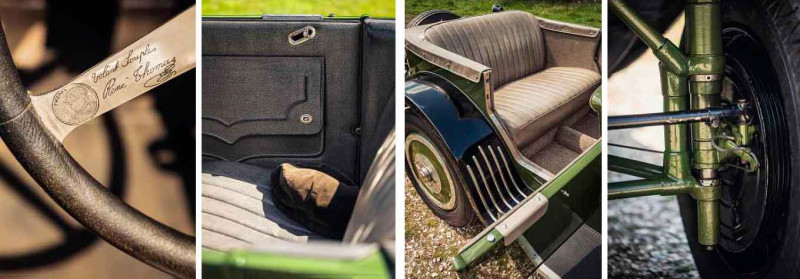
Clearly, though, its breathing could have been better. Tuning company Romagnoni e Pirotta certainly thought so, and duly designed a rather better head. It featured inclined hairpin-sprung valves instead of vertical coilsprung ones, allowing for more efficient combustion chambers of wedge rather than bathtub shape, and it used ingenious scissor-adjustment rockers, on two shafts, rather than conventional rockers on a single shaft. Its camshaft ran in roller bearings and, vitally, it featured normal exhaust ports discharging into normal manifolds, although the convoluted intake tract remained.
Lancia’s works competition cars used this type of head, of which perhaps as few as 12 were made for the 1928 Mille Miglia, but it didn’t arrive under the bonnet of this Lambda, chassis 22066 and build number 12019, for another 42 years. Its cast aluminium camshaft cover is almost Grecian in its architectural angularity, its silvery shine contrasting with the rougher brass of the triple-choke sidedraught Zenith behind and below. And while we’re in the engine bay, noting how its lower sides and the radiator frame form part of the car’s structure, we can take in the Bosch combined magneto and dynamo, the water pump, and what looks like an Autovac to suck the fuel through to the engine.
It’s not an Autovac. It’s called a Lexhausteur, the brainchild of Charles Weymann who was a pre-WW1 test pilot for Nieuport aircraft. He gave his name to a type of body construction using fabric and devised his version of the Autovac idea. This one visually balances the auxiliary oil tank, also bulkhead-mounted, but currently it’s not plumbed in. That’s a future project for Guest, who has already tamed the originally too-powerful water pump with a pair of thermostats and a bypass system after reading a 50-page treatise on the Lambda cooling arrangement by an Australian expert. Another Guest contribution has been those rather lovely wheel discs. A picture of the Lambda, taken when it was new and owned by Dr A Von Salis in Zollikofen, showed it wearing spun-aluminium wheel covers by Fergat of Turin, later lost. Mike managed to track down original Fergat drawings of the corpriruota Tipo 1928 discs’ cross-section, and figured out how to attach the discs to the Bibendum wheels and Rudge-Whitworth hubs. He then created a former out of marine ply, spun five new discs (Guest is strongly of an engineering persuasion), and suddenly the Lancia oozed all of its 1929 glamour all over again.
The moment has come. I position myself in the driving seat, upholstered like its companions by an Italian trimmer in leather to the original, strangely textured specification during that 1970 restoration. Ahead of me is a René Thomas steering wheel from the speed shop of the man who set a speed record of 156mph in 1925, driving a Delage. This is commemorated on a spoke of this lovely period accessory. ‘I have the original steering wheel, too, ’Mike assures me.
The steering wheel is on the Lambda’s right-hand-side, as those of pre-war Italian cars generally were, and a hefty ignition-advance lever pokes from its centre. Beyond and to the left are instruments (speedometer in km/h) set in a panel of the same olive green hue (it’s called Verde Cascine) as the external paintwork.
The pedals are as amodern car’s, with no centre throttle to confuse the long-conditioned brain, and the stubby gearlever has a normal gate pattern, again by no means a given when this car was built, back in the 1920s.
I pull the driver’s door shut, noting the swivelling, nickel-plated thumb pad on the internal handle and how the door overlaps the surrounding bodywork. It’s a neat way of dispensing with the need to engineer perfect panel gaps. I’ve already noticed the firmness of the running boards and the unusual rigidity of the wings’ attachment to the hull. The first Lambdas, according to Wim Oude Weernink in his book La Lancia, had a torsional stiffness ten times greater than a typical open car of the time with a separate chassis, and this later one is likely to be little different despite a slightly less ‘pure’ structural design – bigger door apertures but added sillmembers – intended to make life easier for coachbuilders who wanted to fit a special body, as many did.
There’s no synchromesh, of course, so there’s the usual need to pause in neutral during an upshift or, if impatient, to double-declutch. That process, adding just the right amount of throttle-blip, is obligatory for downshifts, but once you’ve calibrated yourself you can enjoy a very precise, machined-feeling gearchange.
Third gear is epically noisy at low speeds, but soon you’re in top and some peace returns, just lightly breached by the deep, puttery exhaust note typical of a vintage car.
It sounds like a straight-four, with no underlying beat, and is as smooth (or not) as you would expect an engine with four large cylinders and a long stroke (120mm, versus a bore of 82.55mm) to be. This is a torquey, willing engine that shrugs off the Lambda’s 1300kg or so quite happily. Presumably it produces more than the claimed 69bhp of the standard motor, but I content myself with a little over 3000rpmand the Lancia bowls along beautifully, its cruising helped by the later addition of a Laycock overdrive.
As promised, that dynamic beauty has at its core an almost modern feeling of structural one-ness. Cars of this era can usually be felt gently twisting and wobbling as the road’s topography constantly changes, and the steering tends to be springy and a touch unfocused around the centre. You’re often aware of the gyroscopic action of big wheels at the end of a front beam axle, too. The Lambda isn’t like that at all, springy cable-operated brakes notwithstanding.
It’s light on its feet, with surprisingly positive and linearly responding steering, a front end that feels properly in touch with the road, and almost no shake and shudder even when powering through a bumpy bend. That’s the independent front suspension at work, along with the rigid base to which it’s attached. Here lies the template for the way all cars have fundamentally felt for the past 70 years or so, but Lancia was doing it nearly 30 years before that. Get out of a vintage Bentley and into the Lambda, and you’re in another era.
So, what happened to this Lambda after the Niederers’ decorator acquired it? He kept it a very short time, then sold it to Andreas Messerli, who kept it for little more than a year before promising it to a buyer outside his village. But three young enthusiasts got wind of the plan, decided that the Lancia should stay in the village of Wetzikon, and did an alcohol-fuelled deal to buy it at, rather unusually, 40 Swiss francs per kilogramme of weight.
They had plenty of adventures in it from 1954 to 1957, keeping a delightful diary as they performed dodgy repairs and went on road trips, but the man they sold it to merely stored the by-then very tired Lambda until it was rescued by expert restorer Otto Fisch in 1970.
The attention to detail in the subsequent restoration is extraordinary, even down to stamping the correct numbers on the new parts he fitted to mimic the Lancia practice. You can see 12019 on many of the components, a lot of them nickel-plated.
For the engine, Fisch approached Lambda expert Vincenzo Dozza in Kusnacht, near Zurich, who had three of the Pirotta cylinder heads in his possession. Dozza used one of them on a spare block, overbored to 85mm for a 2724cc capacity, to give the Lambda a new and keener heart. It meant that the original engine stayed intact, and Mike Guest still has it in his garage.
In 1992 the Lambda passed to Robert Temperli in Gutenswil, a collector and Vintage Car Club of Switzerland official who was able to uncover the Lancia’s entire registration history. Temperli used it on various events and sold it in 2006 to Bernard Parris, the Lambda’s first owner outside Switzerland. Parris had undertaken restorations of a Bugatti and a Hispano-Suiza, and was well-versed in the niceties of Bentleys, Alvises and Delages. ‘He told me that the Lambda was the best vintage car he had ever driven,’ Guest reveals.
However, Parris had another project on the go and Guest was able to prise the Lancia from his possession. Since then, he and his wife Jacqui have covered over 12,000 miles in it, a fair number of those miles on Alpine passes above the snow line. They are travelling in arguably the first modern car, so why not?
‘I CONTENT MYSELF WITH A LITTLE OVER 3000RPM AND THE LANCIA BOWLS ALONG BEAUTIFULLY’
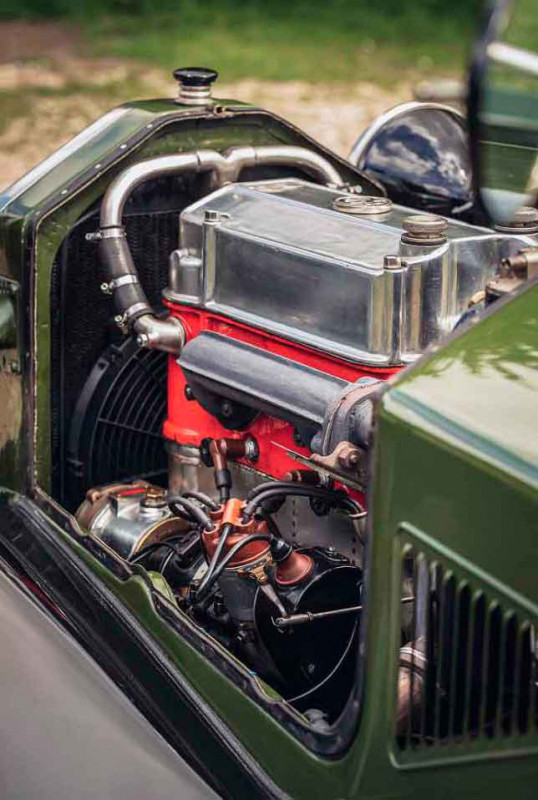
Above The Lambda survived a WW2 escapade before being traded with a decorator for services rendered in 1953; a superb restoration was carried out in 1970.
Right René Thomas wheel commands unusually taut steering, for which independent sliding-pillar front suspension is partly responsible. Left and right Lambda’s unitary construction makes it unusually low for the period; engine is an innovative 2.7-litre narrow-angle V4.
1929 Lancia Lambda Tipo 223
- Engine 2724cc SOHC narrow-angle V4, aluminium block with iron cylinder liners, iron head, Zenith 38HK triple-choke carburettor
- Max Power c80bhp @ 3900rpm
- Max Torque c129lb ft @ 2300rpm
- Transmission Four-speed non-synchromesh manual separate from engine, overdrive, rear-wheel drive
- Steering Worm and wheel
- Suspension
- Front: sliding pillars, integral coil springs, telescopic dampers.
- Rear: live axle, semi-elliptic leaf springs, Hartford friction dampers
- Brakes Cable-operated drums
- Weight c1300kg
- Top speed c85mph


